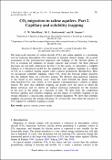CO[subscript 2] migration in saline aquifers. Part 2. Capillary and solubility trapping
Author(s)
MacMinn, Christopher W.; Szulczewski, Michael Lawrence; Juanes, Ruben
DownloadJuanes_CO2 migration.pdf (1.679Mb)
PUBLISHER_POLICY
Publisher Policy
Article is made available in accordance with the publisher's policy and may be subject to US copyright law. Please refer to the publisher's site for terms of use.
Terms of use
Metadata
Show full item recordAbstract
The large-scale injection of carbon dioxide (CO[subscript 2]) into saline aquifers is a promising tool for reducing atmospheric CO[subscript 2] emissions to mitigate climate change. An accurate assessment of the post-injection migration and trapping of the buoyant plume of CO[subscript 2] is essential for estimates of storage capacity and security, but these physical processes are not fully understood. In Part 1 of this series, we presented a complete solution to a theoretical model for the migration and capillary trapping of a plume of CO[subscript 2] in a confined, sloping aquifer with a natural groundwater through-flow. Here, we incorporate solubility trapping, where CO[subscript 2] from the buoyant plume dissolves into the ambient brine via convective mixing. We develop semi-analytical solutions to the model in two limiting cases: when the water beneath the plume saturates with dissolved CO[subscript 2] very slowly or very quickly (‘instantaneously’) relative to plume motion. We show that solubility trapping can greatly slow the speed at which the plume advances, and we derive an explicit analytical expression for the position of the nose of the plume as a function of time. We then study the competition between capillary and solubility trapping, and the impact of solubility trapping on the storage efficiency, a macroscopic measure of plume migration. We show that solubility trapping can increase the storage efficiency by several-fold, even when the fraction of CO[subscript 2] trapped by solubility trapping is small.
Date issued
2011-10Department
Massachusetts Institute of Technology. Department of Civil and Environmental Engineering; Massachusetts Institute of Technology. Department of Mechanical EngineeringJournal
Journal of Fluid Mechanics
Publisher
Cambridge University Press
Citation
MacMinn, C. W., M. L. Szulczewski, and R. Juanes. “CO[subscript 2] Migration in Saline Aquifers. Part 2. Capillary and Solubility Trapping.” Journal of Fluid Mechanics 688 (2011): 321–351. Copyright © Cambridge University Press 2011
Version: Final published version
ISSN
0022-1120
1469-7645